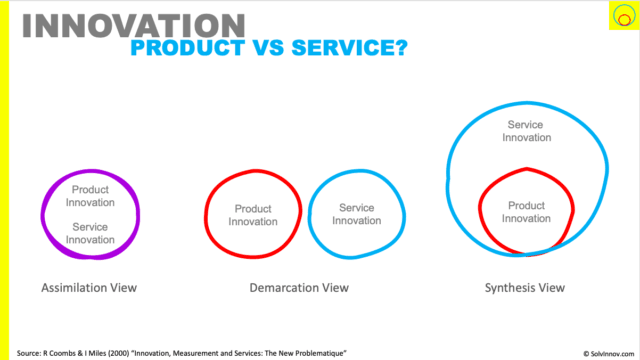The Big Picture
Is innovation in service different to innovation in goods? There are three schools of thought:
- Assimilation view sees product and service innovation as essentially the same.
- Demarcation view sees them as distinct.
- Synthesis view sees service innovation as essentially the same as product innovation where some aspects appear less important in product innovation.

It turns out that service-dominant logic – which sees goods as distribution mechanisms for service – points to taking the synthesis view as the best approach to unlock the innovation problem.
Implications
We should set aside the prevailing view that service and product are different. And that, therefore, innovation in both is different.
The Idea
We are conditioned to believe that there are differences between goods and services. Typically, in marketing, sales and business schools, we learn and define services in comparison to goods. And usually, they are defined as poor relatives. Being inconsistent, inseparable, can’t create an inventory etc.
We see a similar division when we start talking about innovation in service compared to innovation in product. Most innovation theory today is built on product (goods) innovation from manufacturing. With an implication that innovation in service is different and somewhat problematic.
However, if we take a service first view of the world and set out to understand where goods fit, we come up with a different view. This becomes captured in service-dominant logic. Where we find no goods vs service aspect. Rather, we see that goods are a distribution mechanism for service.
So, perhaps product and service innovation are the same?
Or is there a third view? Where product and service innovation share attributes. Yet service innovation has additional attributes, that may be less important, or not all, for product innovation.
We can draw these three views as shown in Figure 1.

There are three views when it comes to whether product-dominant innovation thinking is applicable to service innovation. These are the assimilation, demarcation, and synthesis views shown in Figure 1.
- Assimilation view sees product and service innovation as essentially the same.
- Demarcation view sees them as distinct.
- Synthesis view sees service innovation is essentially the same as product innovation with additional aspects that need addressing.
Product vs Service innovation
Toivonen & Tuominen (2009) listed these five ways (in increasing formality) of how innovation occurs in service firms:
- improving internal processes without a specific project (these can be unintentional or incremental innovations, often by the person providing the service to simplify their work)
- improving a process/service deliberately through an internal innovation project
- innovation projects that test new ideas with pilot customers
- innovation projects tailored for a particular customer problem
- externally funded innovation projects (for example research)
These seem similar to how innovation in goods happens.
If we look into the literature we can produce Figure 2. Coombs and Miles (2000) define the three views and Witel et. al (2016) point out the typical type of innovation that takes place in each view.

I believe the synthesis view is the right view and will help us address the innovation problem. Ignoring the additional aspects of service-dominant innovation leads to issues in an increasingly service-oriented economy.
We can, I admit somewhat casually, suggest dismissing the demarcation view. Since services innovation has been happening for many centuries using approaches associated with product innovation. Even though I would argue about success, service innovation does not appear to need a completely new theory.
Now I just need to convince you the synthesis view is the right one. To do that I look first at if there are similarities, and then if there are the additional aspects.
Are product and service innovation similar?
For the synthesis view (and indeed the assimilation view) to be true there must be similarities between product innovation and service innovation. And there are, particularly in the four big areas shown in Figure 3.
Firstly, Roger’s adoption curve. Users adopt innovations according to Rogers’ adoption curve. That is to say by innovator types first, then early adopters, then the early majority etc. There is no evidence that service adoption would not follow a similar adoption curve. Secondly, Moore’s Crossing the chasm – Moore’s work identified there is a gap (a chasm) to cross between early adopters and the early majority, especially for technology innovations. This is also still true for services.
Additionally, Rogers identified five variables that affect the rate of innovation adoption. We can look to the work of Frambach et al. (1998) to get the comfort that Rogers’ five perceived attributes are also relevant to services innovation. Further, supplier side attributes affect adoption. These supplier side attributes include: marketing / positioning the service and demonstrating reduced customer risk in using the service
Finally, Bass’ adoption curve helps us understand that fast follower innovators (i.e. imitators) can attack the market so well. This still appears true for services.
For the synthesis view to be appropriate we should be able to identify additional aspects applicable to service innovation
Does Service Innovation have additional aspects to address?
Let’s cut straight to the point. Yes, I believe there are additional aspects to address. That is to say, the synthesis view is correct. However, research into these is currently sparse. In Figure 4 we can see the main aspects that have come from my research and literature review into the topic.

I go into detail on these aspects in my article “How does Service Innovation thinking differ from Product Innovation Thinking?“
These additional aspects are:
- Customer Resistance
- Customer expectations from other markets/industries
- Co-value creation
- Context value
- Ecosystem / Network of systems
- Inheriting responsibility from ecosystem
- Measurement
- Continuous nature
You probably can think of a product where some of these aspects are applicable. That’s OK. Our synthesis definition doesn’t say they are not valid. Rather, they are either neglected or less important. Why is this? Well, it goes back to our product-service continuum. There is not a clear division between products and services, so we expect some “products” to have service properties

